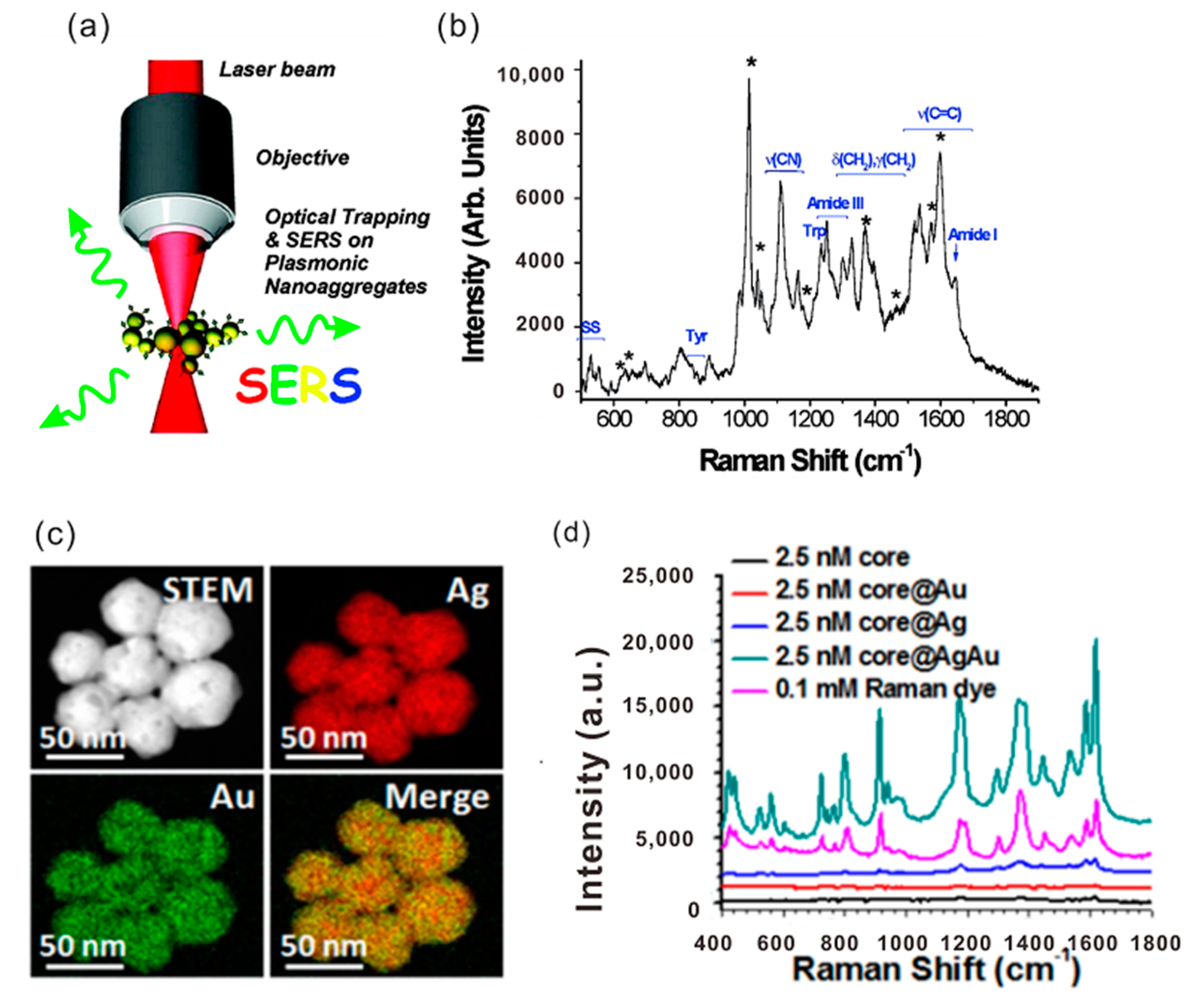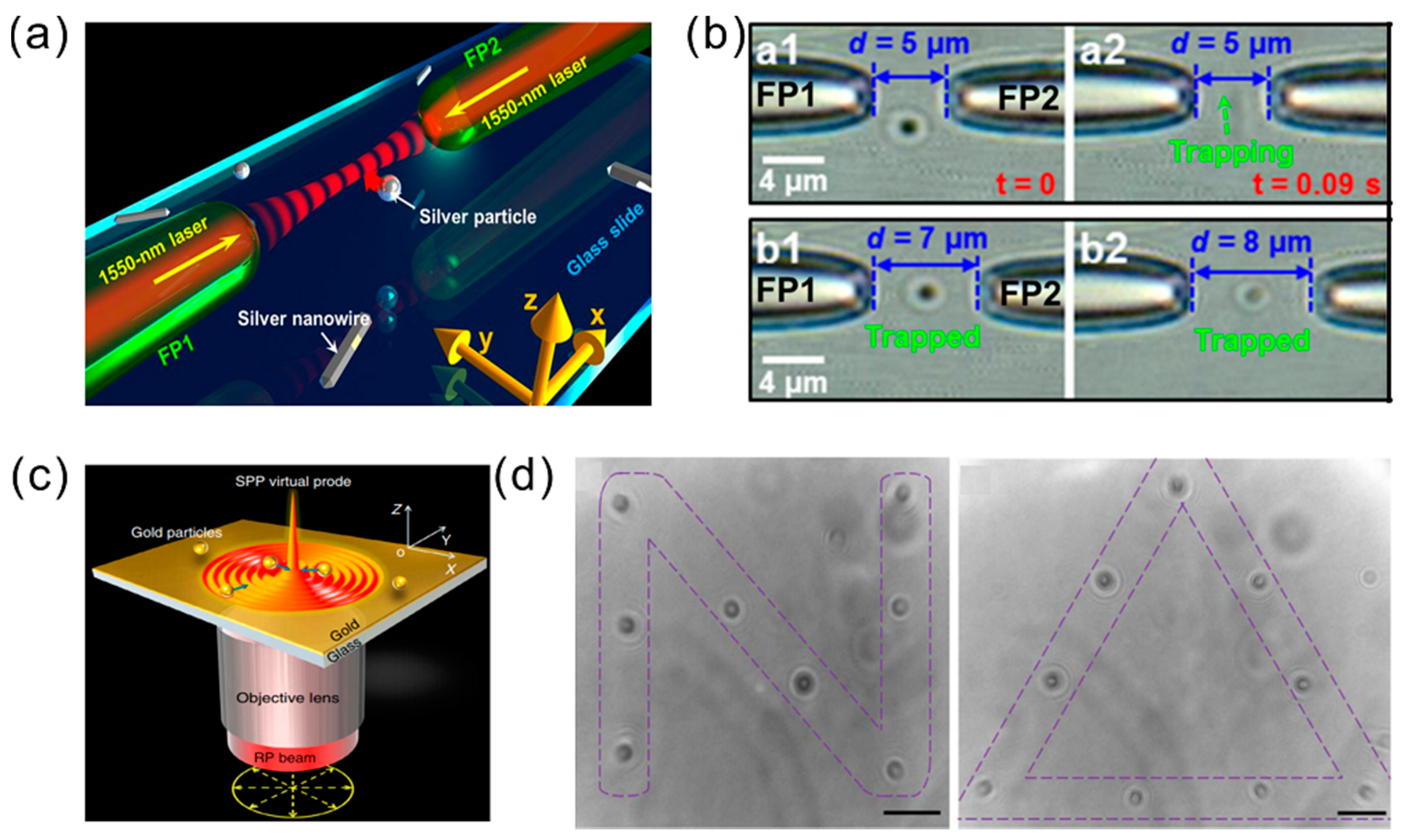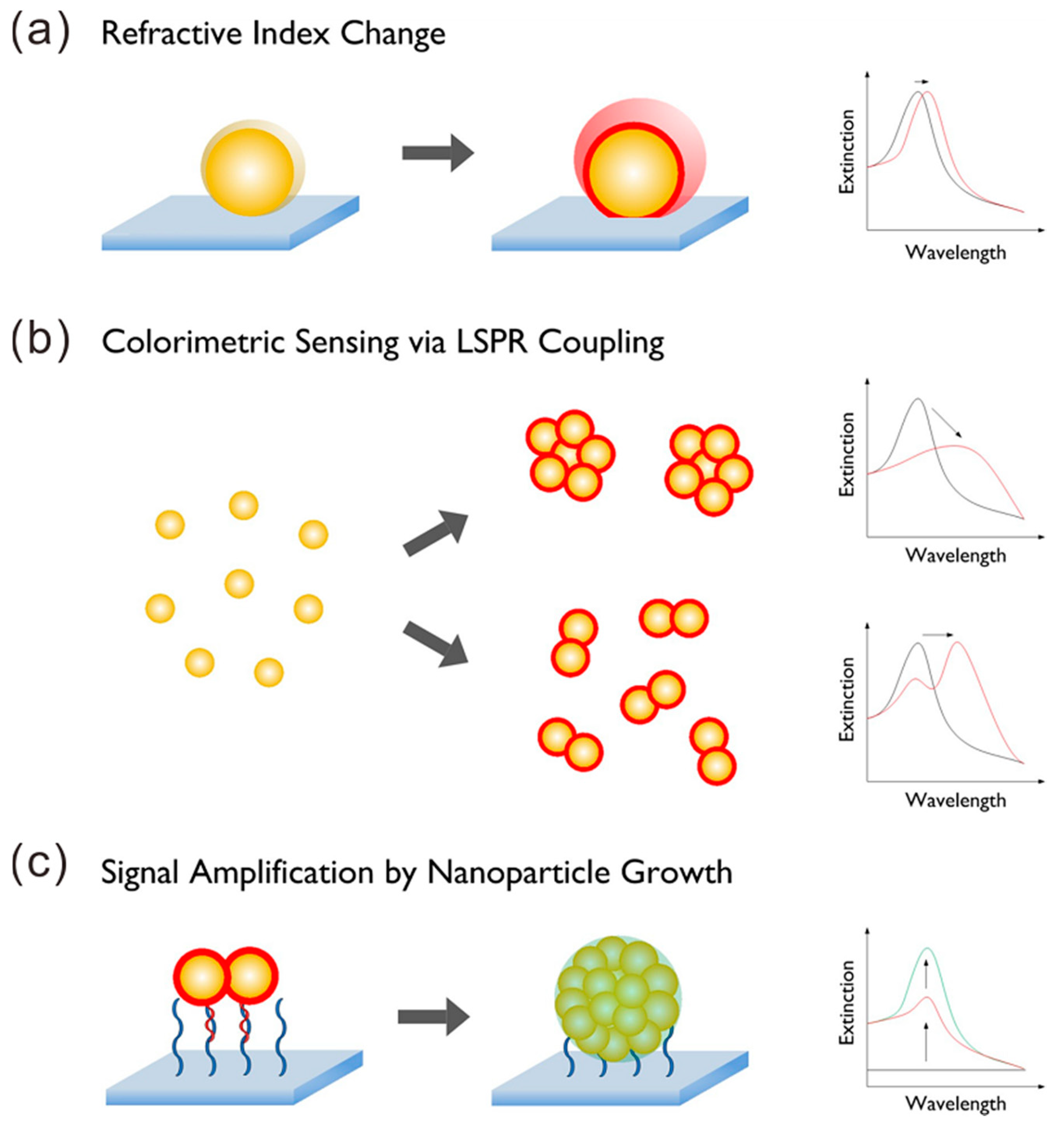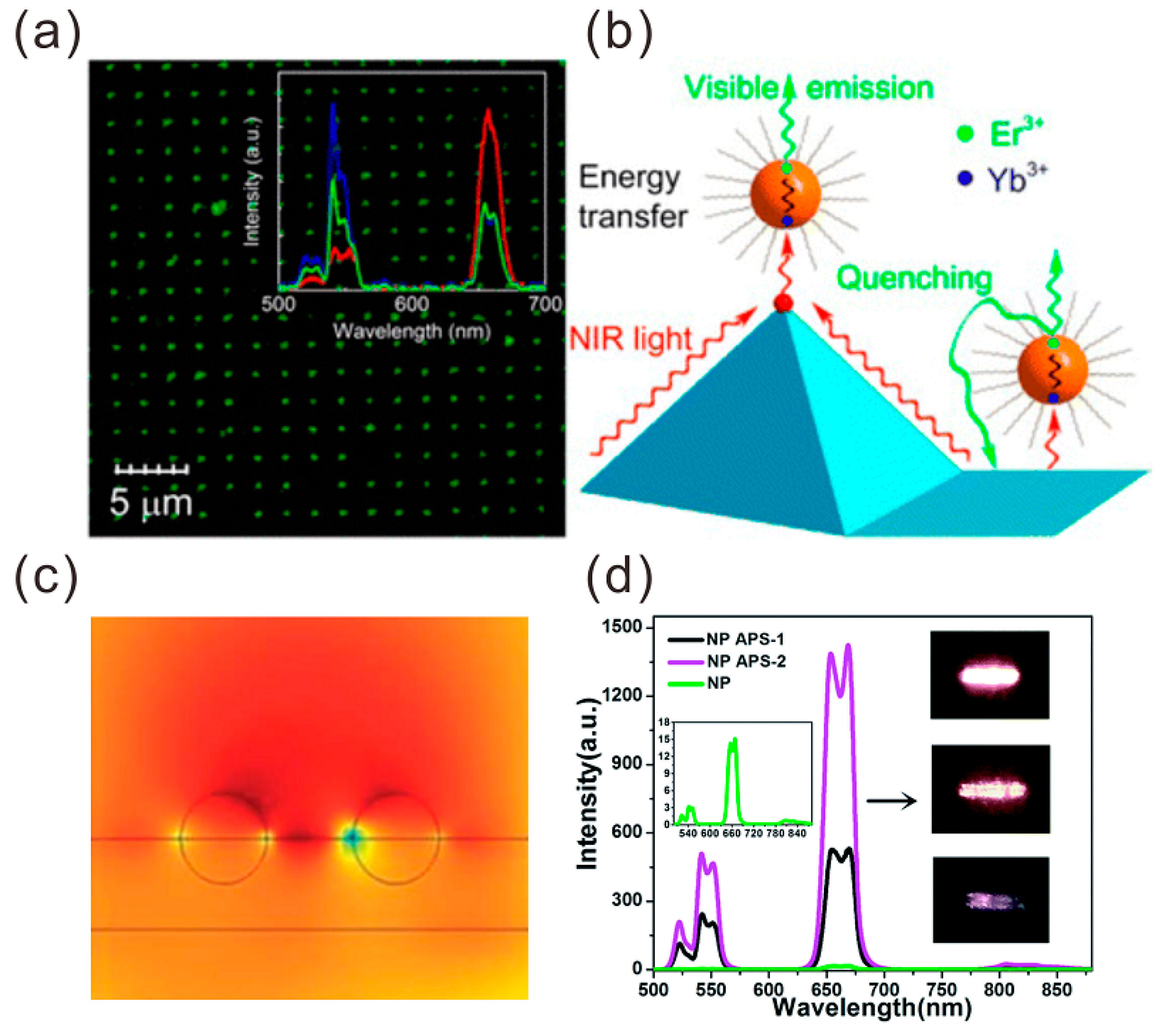Recent Advances of Plasmonic Nanoparticles and their Applications
Abstract
:1. Introduction
2. Fundamentals and Applications of Plasmonics in Au NPs
2.1. Fundamentals
2.2. Applications of SPR in Au NPs
2.2.1. Surface Enhancement Raman Scattering
2.2.2. Fluorescence Modulation
2.2.3. Optical Trapping and Manipulation
2.2.4. Sensing and Imaging with Plasmon Resonance of NPs
3. Plasmon-Enhanced Upconversion Luminescence
3.1. Plasmon-Enhanced Absorption
3.1.1. Plasmon-Enhanced Emission
3.1.2. Plasmon-Enhanced Energy Transfer
3.2. Applications of Plasmonic UCNPs Systems
4. Chirality Plasmonic Metasurface
4.1. Chiral Metamaterials Based on Top–Down Fabrication Methods
4.2. Chiral Metamaterials Based on Bottom–Up Fabrication Methods
5. Conclusions
Funding
Conflicts of Interest
References
- De Aberasturi, D.J.; Serrano-Montes, A.B.; Liz-Marzán, L.M. Modern applications of plasmonic nanoparticles: From energy to health. Adv. Opt. Mater. 2015, 3, 602–617. [Google Scholar] [CrossRef]
- Amendola, V.; Pilot, R.; Frasconi, M.; Marago, O.M.; Iati, M.A. Surface plasmon resonance in gold nanoparticles: A review. J. Phys. Condens. Matter. 2017, 29, 203002. [Google Scholar] [CrossRef] [PubMed]
- Ogawa, S.; Kimata, M. Metal-insulator-metal-based plasmonic metamaterial absorbers at visible and infrared wavelengths: A review. Materials 2018, 11. [Google Scholar] [CrossRef] [PubMed]
- Li Volsi, A.; Scialabba, C.; Vetri, V.; Cavallaro, G.; Licciardi, M.; Giammona, G. Near-infrared light responsive folate targeted gold nanorods for combined photothermal-chemotherapy of osteosarcoma. ACS Appl. Mater. Interfaces 2017, 9, 14453–14469. [Google Scholar] [CrossRef] [PubMed]
- Jang, Y.H.; Jang, Y.J.; Kim, S.; Quan, L.N.; Chung, K.; Kim, D.H. Plasmonic solar cells: From rational design to mechanism overview. Chem. Rev. 2016, 116, 14982–15034. [Google Scholar] [CrossRef] [PubMed]
- Khoo, E.H.; Leong, E.S.P.; Wu, S.J.; Phua, W.K.; Hor, Y.L.; Liu, Y.J. Effects of asymmetric nanostructures on the extinction difference properties of actin biomolecules and filaments. Sci. Rep. 2016, 6, 19658. [Google Scholar] [CrossRef] [PubMed] [Green Version]
- Cheng, J.J.; Hill, E.H.; Zheng, Y.B.; He, T.C.; Liu, Y.J. Optically active plasmonic resonance in self-assembled nanostructures. Mater. Chem. Front. 2018, 2, 662–678. [Google Scholar] [CrossRef]
- Jiang, N.N.; Zhuo, X.L.; Wang, J.F. Active plasmonics: Principles, structures, and applications. Chem. Rev. 2018, 118, 3054–3099. [Google Scholar] [CrossRef] [PubMed]
- Bigdeli, A.; Ghasemi, F.; Golmohammadi, H.; Abbasi-Moayed, S.; Nejad, M.A.F.; Fahimi-Kashani, N.; Jafarinejad, S.; Shahrajabian, M.; Hormozi-Nezhad, M.R. Nanoparticle-based optical sensor arrays. Nanoscale 2017, 9, 16546–16563. [Google Scholar] [CrossRef] [PubMed]
- Cai, Z.Y.; Liu, Y.J.; Lu, X.M.; Teng, J.H. In situ “doping” inverse silica opals with size-controllable gold nanoparticles for refractive index sensing. J. Phys. Chem. C 2013, 117, 9440–9445. [Google Scholar] [CrossRef]
- Li, J.; Zhu, Z.; Zhu, B.; Ma, Y.; Lin, B.; Liu, R.; Song, Y.; Lin, H.; Tu, S.; Yang, C. Surface-enhanced Raman scattering active plasmonic nanoparticles with ultrasmall interior nanogap for multiplex quantitative detection and cancer cell imaging. Anal. Chem. 2016, 88, 7828–7836. [Google Scholar] [CrossRef] [PubMed]
- Qiu, H.W.; Wang, M.Q.; Yang, Z.; Jiang, S.Z.; Liu, Y.J.; Li, L.; Cao, M.H.; Li, J.J. A new route for the synthesis of a Ag nanopore-inlay-nanogap structure: Integrated Ag-core@graphene-shell@Ag-jacket nanoparticles for high-efficiency SERS detection. Chem. Commun. 2017, 53, 8691–8694. [Google Scholar] [CrossRef] [PubMed]
- Lu, Z.Y.; Si, H.P.; Li, Z.; Yu, J.; Liu, Y.J.; Feng, D.J.; Zhang, C.; Yang, W.; Man, B.Y.; Jiang, S.Z. Sensitive, reproducible, and sTable 3D plasmonic hybrids with bilayer WS2 as nanospacer for SERS analysis. Opt. Express 2018, 26, 21626–21641. [Google Scholar] [CrossRef] [PubMed]
- Lu, Z.Y.; Liu, Y.J.; Wang, M.H.; Zhang, C.; Li, Z.; Huo, Y.Y.; Li, Z.; Xu, S.C.; Man, B.Y.; Jiang, S.Z. A novel natural surface-enhanced Raman spectroscopy (SERS) substrate based on graphene oxide-Ag nanoparticles-Mytiluscoruscus hybrid system. Sens. Actuator B Chem. 2018, 261, 1–10. [Google Scholar] [CrossRef]
- Zhang, Z.; Kinzel, D.; Deckert, V. Photo-induced or plasmon-induced reaction: Investigation of the light-induced Azo-coupling of amino groups. J. Phys. Chem. C 2016, 120, 20978–20983. [Google Scholar] [CrossRef]
- Ke, S.L.; Wang, B.; Huang, H.; Long, H.; Wang, K.; Lu, P.X. Plasmonic absorption enhancement in periodic cross-shaped graphene arrays. Opt. Express 2015, 23, 8888–8900. [Google Scholar] [CrossRef] [PubMed]
- Amendola, V. Surface plasmon resonance of silver and gold nanoparticles in the proximity of graphene studied using the discrete dipole approximation method. Phys. Chem. Chem. Phys. 2016, 18, 2230–2241. [Google Scholar] [CrossRef] [PubMed]
- Li, Q.; Wei, H.; Xu, H.X. Resolving single plasmons generated by multiquantum-emitters on a silver nanowire. Nano Lett. 2014, 14, 3358–3363. [Google Scholar] [CrossRef] [PubMed]
- Gramotnev, D.K.; Bozhevolnyi, S.I. Plasmonics beyond the diffraction limit. Nat. Photonics 2010, 4, 83–91. [Google Scholar] [CrossRef]
- Wang, B.; Chew, A.B.; Teng, J.H.; Si, G.Y.; Danner, A.J. Subwavelength lithography by waveguide mode interference. Appl. Phys. Lett. 2011, 99, 151106. [Google Scholar] [CrossRef]
- Wang, B.; Aigouy, L.; Bourhis, E.; Gierak, J.; Hugonin, J.P.; Lalanne, P. Efficient generation of surface plasmon by single-nanoslit illumination under highly oblique incidence. Appl. Phys. Lett. 2009, 94, 011114. [Google Scholar] [CrossRef]
- Sonnichsen, C.; Franzl, T.; Wilk, T.; von Plessen, G.; Feldmann, J.; Wilson, O.; Mulvaney, P. Drastic reduction of plasmon damping in gold nanorods. Phys. Rev. Lett. 2002, 88, 077402. [Google Scholar] [CrossRef] [PubMed]
- Jain, P.K.; Lee, K.S.; El-Sayed, I.H.; El-Sayed, M.A. Calculated absorption and scattering properties of gold nanoparticles of different size, shape, and composition: Applications in biological imaging and biomedicine. J. Phys. Chem. B 2006, 110, 7238–7248. [Google Scholar] [CrossRef] [PubMed]
- Hentschel, M.; Saliba, M.; Vogelgesang, R.; Giessen, H.; Alivisatos, A.P.; Liu, N. Transition from isolated to collective modes in plasmonic oligomers. Nano Lett. 2010, 10, 2721–2726. [Google Scholar] [CrossRef] [PubMed]
- Chikkaraddy, R.; de Nijs, B.; Benz, F.; Barrow, S.J.; Scherman, O.A.; Rosta, E.; Demetriadou, A.; Fox, P.; Hess, O.; Baumberg, J.J. Single-molecule strong coupling at room temperature in plasmonic nanocavities. Nature 2016, 535, 127–130. [Google Scholar] [CrossRef] [PubMed] [Green Version]
- Bouillard, J.S.; Dickson, W.; O’Connor, D.P.; Wurtz, G.A.; Zayats, A.V. Low-temperature plasmonics of metallic nanostructures. Nano Lett. 2012, 12, 1561–1565. [Google Scholar] [CrossRef] [PubMed]
- Bao, Y.J.; Zhao, B.; Hou, D.J.; Liu, J.S.; Wang, F.; Wang, X.; Cui, T. The redshift of surface plasmon resonance of colloidal gold nanoparticles induced by pressure with diamond anvil cell. J. Appl. Phys. 2014, 115, 223503. [Google Scholar] [CrossRef]
- Messina, E.; Cavallaro, E.; Cacciola, A.; Saija, R.; Borghese, F.; Denti, P.; Fazio, B.; D’Andrea, C.; Gucciardi, P.G.; Iati, M.A.; et al. Manipulation and raman spectroscopy with optically trapped metal nanoparticles obtained by pulsed laser ablation in liquids. J. Phys. Chem. C 2011, 115, 5115–5122. [Google Scholar] [CrossRef]
- Chen, J.W.; Wang, K.; Long, H.; Han, X.B.; Hu, H.B.; Liu, W.W.; Wang, B.; Lu, P.X. Tungsten disulfide-gold nanohole hybrid metasurfaces for nonlinear metalenses in the visible region. Nano Lett. 2018, 18, 1344–1350. [Google Scholar] [CrossRef] [PubMed]
- Schlucker, S. Surface-enhanced Raman spectroscopy: Concepts and chemical applications. Angew. Chem. Int. Ed. Engl. 2014, 53, 4756–4795. [Google Scholar] [CrossRef] [PubMed]
- Tran, M.; Whale, A.; Padalkar, S. Exploring the efficacy of platinum and palladium nanostructures for organic molecule detection via Raman spectroscopy. Sensors 2018, 18, 147. [Google Scholar] [CrossRef] [PubMed]
- You, Y.; Song, Q.W.; Wang, L.; Niu, C.X.; Na, N.; Ouyang, J. Silica-coated triangular gold nanoprisms as distance-dependent plasmon-enhanced fluorescence-based probes for biochemical applications. Nanoscale 2016, 8, 18150–18160. [Google Scholar] [CrossRef] [PubMed]
- Sukharev, M.; Nitzan, A. Optics of exciton-plasmon nanomaterials. J. Phys. Condens. Matter 2017, 29, 443003. [Google Scholar] [CrossRef] [PubMed] [Green Version]
- Righini, M.; Ghenuche, P.; Cherukulappurath, S.; Myroshnychenko, V.; Garcia de Abajo, F.J.; Quidant, R. Nano-optical trapping of Rayleigh particles and Escherichia coli bacteria with resonant optical antennas. Nano Lett. 2009, 9, 3387–3391. [Google Scholar] [CrossRef] [PubMed]
- Xu, X.H.; Cheng, C.; Zhang, Y.; Lei, H.X.; Li, B.J. Dual focused coherent beams for three-dimensional optical trapping and continuous rotation of metallic nanostructures. Sci. Rep. 2016, 6, 29449. [Google Scholar] [CrossRef] [PubMed] [Green Version]
- Min, C.J.; Shen, Z.; Shen, J.F.; Zhang, Y.Q.; Fang, H.; Yuan, G.H.; Du, L.P.; Zhu, S.W.; Lei, T.; Yuan, X.C. Focused plasmonic trapping of metallic particles. Nat. Commun. 2013, 4, 2891. [Google Scholar] [CrossRef] [PubMed]
- Sugawa, K.; Tahara, H.; Yamashita, A.; Otsuki, J.; Sagara, T.; Harumoto, T.; Yanagida, S. Refractive index susceptibility of the plasmonic palladium nanoparticle: Potential as the third plasmonic sensing material. ACS Nano 2015, 9, 1895–1904. [Google Scholar] [CrossRef] [PubMed]
- Sepúlveda, B.; Angelomé, P.C.; Lechuga, L.M.; Liz-Marzán, L.M. LSPR-based nanobiosensors. Nano Today 2009, 4, 244–251. [Google Scholar] [CrossRef]
- Guo, L.H.; Jackman, J.A.; Yang, H.H.; Chen, P.; Cho, N.J.; Kim, D.H. Strategies for enhancing the sensitivity of plasmonic nanosensors. Nano Today 2015, 10, 213–239. [Google Scholar] [CrossRef]
- Feng, B.; Zhu, R.; Xu, S.; Chen, Y.; Di, J. A sensitive LSPR sensor based on glutathione-functionalized gold nanoparticles on a substrate for the detection of Pb2+ ions. RSC Adv. 2018, 8, 4049–4056. [Google Scholar] [CrossRef]
- Wang, F.; Han, Y.; Lim, C.S.; Lu, Y.H.; Wang, J.; Xu, J.; Chen, H.Y.; Zhang, C.; Hong, M.H.; Liu, X.G. Simultaneous phase and size control of upconversion nanocrystals through lanthanide doping. Nature 2010, 463, 1061–1065. [Google Scholar] [CrossRef] [PubMed]
- Markus, H.; Helmut, S. Upconverting nanoparticles. Angew. Chem. Int. Ed. 2011, 50, 5808–5829. [Google Scholar]
- Li, X.M.; Zhang, F.; Zhao, D.Y. Lab on upconversion nanoparticles: Optical properties and applications engineering via designed nanostructure. Chem. Soc. Rev. 2015, 44, 1346–1378. [Google Scholar] [CrossRef] [PubMed]
- Han, S.Y.; Deng, R.R.; Xie, X.J.; Liu, X.G. Enhancing luminescence in Lanthanide-doped upconversion nanoparticles. Angew. Chem. Int. Ed. 2014, 53, 11702–11715. [Google Scholar] [CrossRef] [PubMed]
- Chen, X.; Jin, L.M.; Kong, W.; Sun, T.Y.; Zhang, W.F.; Liu, X.H.; Fan, J.; Yu, S.F.; Wang, F. Confining energy migration in upconversion nanoparticles towards deep ultraviolet lasing. Nat. Comm. 2016, 7, 10304. [Google Scholar] [CrossRef] [PubMed] [Green Version]
- Rohani, S.; Quintanilla, M.; Tuccio, S.; De Angelis, F.; Cantelar, E.; Govorov, A.O.; Razzari, L.; Vetrone, F. Enhanced luminescence, collective heating, and nanothermometry in an ensemble system composed of Lanthanide-doped upconverting nanoparticles and gold nanorods. Adv. Opt. Mater. 2015, 3, 1606–1613. [Google Scholar] [CrossRef]
- Yin, Z.; Li, H.; Xu, W.; Cui, S.B.; Zhou, D.L.; Chen, X.; Zhu, Y.S.; Qin, G.S.; Song, H.W. Local field modulation induced three-order upconversion enhancement: Combining surface plasmon effect and photonic crystal effect. Adv. Mater. 2016, 28, 2518–2525. [Google Scholar] [CrossRef] [PubMed]
- Park, W.; Lu, D.W.; Ahn, S.M. Plasmon enhancement of luminescence upconversion. Chem. Soc. Rev. 2015, 44, 2940–2962. [Google Scholar] [CrossRef] [PubMed]
- Liu, B.; Li, C.X.; Yang, P.P.; Hou, Z.Y.; Lin, J. 808-nm-light-excited Lanthanide-doped nanoparticles: Rational design, luminescence control and theranostic applications. Adv. Mater. 2017, 29, 1605434. [Google Scholar] [CrossRef] [PubMed]
- Chen, X.; Xu, W.; Zhang, L.H.; Bai, X.; Cui, S.B.; Zhou, D.L.; Yin, Z.; Song, H.W.; Kim, D.H. Large upconversion enhancement in the “Islands” Au–Ag Alloy/NaYF4: Yb3+, Tm3+/Er3+ composite films, and fingerprint identification. Adv. Funct. Mater. 2015, 25, 5462–5471. [Google Scholar] [CrossRef]
- Yin, Z.; Zhou, D.L.; Xu, W.; Cui, S.B.; Chen, X.; Wang, H.; Xu, S.H.; Song, H.W. Plasmon-enhanced upconversion luminescence on vertically aligned gold nanorod monolayer supercrystals. ACS Appl. Mater. Interfaces 2016, 8, 11667–11674. [Google Scholar] [CrossRef] [PubMed]
- Kwon, S.J.; Lee, G.Y.; Jung, K.; Jang, H.S.; Park, J.S.; Ju, H.; Han, I.; Ko, H. A plasmonic platform with disordered array of metal nanoparticles for three-order enhanced upconversion luminescence and highly sensitive near-infrared photodetector. Adv. Mater. 2016, 28, 7899–7909. [Google Scholar] [CrossRef] [PubMed]
- Zhang, H.; Li, Y.J.; Ivanov, I.A.; Qu, Y.Q.; Huang, Y.; Duan, X.F. Plasmonic modulation of the upconversion fluorescence in NaYF4:Yb/Tm hexaplate nanocrystals using gold nanoparticles or nanoshells. Angew. Chem. Int. Ed. 2010, 49, 2865–2868. [Google Scholar] [CrossRef] [PubMed]
- He, J.J.; Zheng, W.; Ligmajer, F.L.; Chan, C.F.; Bao, Z.Y.; Wong, K.L.; Chen, X.Y.; Hao, J.H.; Dai, J.Y.; Yu, S.F.; et al. Plasmonic enhancement and polarization dependence of nonlinear upconversion emissions from single gold nanorod@SiO2@CaF2:Yb3+, Er3+ hybrid core–shell–satellite nanostructures. Light Sci. Appl. 2017, 6, e16217. [Google Scholar] [CrossRef] [PubMed]
- Yuan, P.Y.; Lee, Y.H.; Gnanasammandhan, M.K.; Guan, Z.P.; Zhang, Y.; Xu, Q.H. Plasmon enhanced upconversion luminescence of NaYF4:Yb, Er@SiO2@Ag core–shell nanocomposites for cell imaging. Nanoscale 2012, 4, 5132–5137. [Google Scholar] [CrossRef] [PubMed]
- Yin, D.G.; Wang, C.C.; Ouyang, J.; Zhang, X.Y.; Jiao, Z.; Feng, Y.; Song, K.L.; Liu, B.; Cao, X.Z.; Zhang, L.; et al. Synthesis of a novel core−shell nanocomposite Ag@SiO2@Lu2O3:Gd/Yb/Er for large enhancing upconversion luminescence and bioimaging. ACS Appl. Mater. Interfaces 2014, 6, 18480–18488. [Google Scholar] [CrossRef] [PubMed]
- Li, H.Q.; Deng, Q.Q.; Liu, B.; Yang, J.H.; Wu, B. Fabrication of core@spacer@shell Aunanorod@mSiO2@Y2O3:Er nanocomposites with enhanced upconversion fluorescence. RSC Adv. 2016, 6, 13343–13348. [Google Scholar] [CrossRef]
- Kang, F.W.; He, J.J.; Sun, T.Y.; Bao, Z.Y.; Wang, F.; Lei, D.Y. Plasmonic dual-enhancement and precise color tuning of gold nanorod@SiO2 coupled core–shell–shell upconversion nanocrystals. Adv. Funct. Mater. 2017, 27, 1701842. [Google Scholar] [CrossRef]
- Sun, Q.C.; Mundoor, H.; Ribot, J.C.; Singh, V.; Smalyukh, I.; Nagpal, P. Plasmon-enhanced energy transfer for improved upconversion of infrared radiation in doped-Lanthanide nanocrystals. Nano Lett. 2014, 14, 101–106. [Google Scholar] [CrossRef] [PubMed]
- Wang, Y.; Yang, Z.; Shao, B.; Yang, J.; Li, J.; Qiu, J.; Song, Z. Tunable and ultra-broad plasmon enhanced upconversion emission of NaYF4:Yb3+, Er3+ nanoparticles deposited on Au films with papilla Au nanoparticles. RSC Adv. 2016, 6, 56963–56970. [Google Scholar] [CrossRef]
- Li, N.; Zhao, P.X.; Astruc, D. Anisotropic gold nanoparticles: Synthesis, properties, applications, and toxicity. Angew. Chem. Int. Ed. 2014, 53, 1756–1789. [Google Scholar] [CrossRef] [PubMed]
- Chen, C.W.; Lee, P.H.; Chan, Y.C.; Hsiao, M.; Chen, C.H.; Wu, P.C.; Wu, P.R.; Tsai, D.P.; Tu, D.; Chen, X.Y.; et al. Plasmon-induced hyperthermia: Hybrid upconversion NaYF4:Yb/Er and gold nanomaterials for oral cancer photothermal therapy. J. Mater. Chem. B 2015, 3, 8293–8302. [Google Scholar] [CrossRef]
- Huang, Y.; Skripka, A.; Labrador-Paez, L.; Sanz-Rodriguez, F.; Haro-Gonzalez, P.; Jaque, D.; Rosei, F.; Vetrone, F. Upconverting nanocomposites with combined photothermal and photodynamic effects. Nanoscale 2018, 10, 791–799. [Google Scholar] [CrossRef] [PubMed]
- Wang, Z.J.; Cheng, F.; Winsor, T.; Liu, Y.M. Optical chiral metamaterials: A review of the fundamentals, fabrication methods and applications. Nanotechnology 2016, 27, 412001. [Google Scholar] [CrossRef] [PubMed]
- Gansel, J.K.; Thiel, M.; Rill, M.S.; Decker, M.; Bade, K.; Saile, V.; von Freymann, G.; Linden, S.; Wegener, M. Gold helix photonic metamaterial as broadband circular polarizer. Science 2009, 325, 1513–1515. [Google Scholar] [CrossRef] [PubMed]
- Kaschke, J.; Gansel, J.K.; Wegener, M. On metamaterial circular polarizers based on metal N-helices. Opt. Express 2012, 20, 26012–26020. [Google Scholar] [CrossRef] [PubMed]
- Gansel, J.K.; Latzel, M.; Frolich, A.; Kaschke, J.; Thiel, M.; Wegener, M. Tapered gold-helix metamaterials as improved circular polarizers. Appl. Phys. Lett. 2012, 100, 101109. [Google Scholar] [CrossRef]
- Thiel, M.; Rill, M.S.; von Freymann, G.; Wegener, M. Three-dimensional bi-chiral photonic crystals. Adv. Mater. 2009, 21, 4680–4682. [Google Scholar] [CrossRef]
- Radke, A.; Gissibl, T.; Klotzbucher, T.; Braun, P.V.; Giessen, H. Three-dimensional bichiral plasmonic crystals fabricated by direct laser writing and electroless silver plating. Adv. Mater. 2011, 23, 3018–3021. [Google Scholar] [CrossRef] [PubMed]
- Koops, H.W.P.; Kretz, J.; Rudolph, M.; Weber, M. Constructive three-dimensional lithography with electron-beam induced deposition for quantum effect devices. J. Vac. Sci. Technol. B 1993, 11, 2386–2389. [Google Scholar] [CrossRef]
- Utke, I.; Hoffmann, P.; Melngailis, J. Gas-assisted focused electron beam and ion beam processing and fabrication. J. Vac. Sci. Technol. B 2008, 26, 1197–1276. [Google Scholar] [CrossRef]
- Esposito, M.; Tasco, V.; Cuscuna, M.; Todisco, F.; Benedetti, A.; Tarantini, I.; De Giorgi, M.; Sanvitto, D.; Passaseo, A. Nanoscale 3D chiral plasmonic helices with circular dichroism at visible frequencies. ACS Photonics 2015, 2, 105–114. [Google Scholar] [CrossRef]
- Mark, A.G.; Gibbs, J.G.; Lee, T.C.; Fischer, P. Hybrid nanocolloids with programmed three-dimensional shape and material composition. Nat. Mater. 2013, 12, 802–807. [Google Scholar] [CrossRef] [PubMed]
- Yeom, B.; Zhang, H.; Zhang, H.; Park, J.I.; Kim, K.; Govorov, A.O.; Kotov, N.A. Chiral plasmonic nanostructures on achiral nanopillars. Nano Lett. 2013, 13, 5277–5283. [Google Scholar] [CrossRef] [PubMed]
- Xiao, D.; Liu, Y.J.; Yin, S.; Liu, J.; Ji, W.; Wang, B.; Luo, D.; Li, G.; Sun, X.W. Liquid-crystal-loaded chiral metasurfaces for reconfigurable multiband spin-selective light absorption. Opt. Express 2018, 26, 25305–25314. [Google Scholar] [CrossRef]
- Liu, N.; Liu, H.; Zhu, S.N.; Giessen, H. Stereometamaterials. Nat. Photonics 2009, 3, 157–162. [Google Scholar] [CrossRef]
- Karimullah, A.S.; Jack, C.; Tullius, R.; Rotello, V.M.; Cooke, G.; Gadegaard, N.; Barron, L.D.; Kadodwala, M. Disposable plasmonics: Plastic templated plasmonic metamaterials with tunable chirality. Adv. Mater. 2015, 27, 5610–5616. [Google Scholar] [CrossRef] [PubMed]
- Cui, Y.H.; Kang, L.; Lan, S.F.; Rodrigues, S.; Cai, W.S. Giant chiral optical response from a twisted-arc metamaterial. Nano Lett. 2014, 14, 1021–1025. [Google Scholar] [CrossRef] [PubMed]
- Decker, M.; Ruther, M.; Kriegler, C.E.; Zhou, J.; Soukoulis, C.M.; Linden, S.; Wegener, M. Strong optical activity from twisted-cross photonic metamaterials. Opt. Lett. 2009, 34, 2501–2503. [Google Scholar] [CrossRef] [PubMed]
- Leong, E.S.P.; Deng, J.; Khoo, E.H.; Wu, S.J.; Phua, W.K.; Liu, Y.J. Fabrication of suspended, three-dimensional chiral plasmonic nanostructures with single-step electron-beam lithography. RSC Adv. 2015, 5, 96366–96371. [Google Scholar] [CrossRef]
- Ogier, R.; Fang, Y.R.; Svedendahl, M.; Johansson, P.; Kall, M. Macroscopic layers of chiral plasmonic nanoparticle oligomers from colloidal lithography. ACS Photonics 2014, 1, 1074–1081. [Google Scholar] [CrossRef]
- Yan, W.J.; Xu, L.G.; Xu, C.L.; Ma, W.; Kuang, H.; Wang, L.B.; Kotov, N.A. Self-assembly of chiral nanoparticle pyramids with strong R/S optical activity. J. Am. Chem. Soc. 2012, 134, 15114–15121. [Google Scholar] [CrossRef] [PubMed]
- Mastroianni, A.J.; Claridge, S.A.; Alivisatos, A.P. Pyramidal and chiral groupings of gold nanocrystals assembled using DNA scaffolds. J. Am. Chem. Soc. 2009, 131, 8455–8459. [Google Scholar] [CrossRef] [PubMed]
- Lan, X.; Chen, Z.; Dai, G.L.; Lu, X.X.; Ni, W.H.; Wang, Q.B. Bifacial DNA origami-directed discrete, three-dimensional, anisotropic plasmonic nanoarchitectures with tailored optical chirality. J. Am. Chem. Soc. 2013, 135, 11441–11444. [Google Scholar] [CrossRef] [PubMed]
- Shen, X.B.; Asenjo-Garcia, A.; Liu, Q.; Jiang, Q.; Garcia de Abajo, F.J.; Liu, N.; Ding, B.Q. Three-dimensional plasmonic chiral tetramers assembled by DNA origami. Nano Lett. 2013, 13, 2128–2133. [Google Scholar] [CrossRef] [PubMed]
- Kuzyk, A.; Schreiber, R.; Fan, Z.Y.; Pardatscher, G.; Roller, E.M.; Hogele, A.; Simmel, F.C.; Govorov, A.O.; Liedl, T. DNA-based self-assembly of chiral plasmonic nanostructures with tailored optical response. Nature 2012, 483, 311–314. [Google Scholar] [CrossRef] [PubMed] [Green Version]
- Querejeta-Fernandez, A.; Chauve, G.; Methot, M.; Bouchard, J.; Kumacheva, E. Chiral plasmonic films formed by gold nanorods and cellulose nanocrystals. J. Am. Chem. Soc. 2014, 136, 4788–4793. [Google Scholar] [CrossRef] [PubMed]
- Bitar, R.; Agez, G.; Mitov, M. Cholesteric liquid crystal self-organization of gold nanoparticles. Soft Matter 2011, 7, 8198–8206. [Google Scholar] [CrossRef]
- Chen, C.L.; Zhang, P.J.; Rosi, N.L. A new peptide-based method for the design and synthesis of nanoparticle superstructures: Construction of highly ordered gold nanoparticle double helices. J. Am. Chem. Soc. 2008, 130, 13555–13557. [Google Scholar] [CrossRef] [PubMed]
- Zhu, Z.N.; Liu, W.J.; Li, Z.T.; Han, B.; Zhou, Y.L.; Gao, Y.; Tang, Z.Y. Manipulation of collective optical activity in one-dimensional plasmonic assembly. ACS Nano 2012, 6, 2326–2332. [Google Scholar] [CrossRef] [PubMed]










© 2018 by the authors. Licensee MDPI, Basel, Switzerland. This article is an open access article distributed under the terms and conditions of the Creative Commons Attribution (CC BY) license (http://creativecommons.org/licenses/by/4.0/).
Share and Cite
Liu, J.; He, H.; Xiao, D.; Yin, S.; Ji, W.; Jiang, S.; Luo, D.; Wang, B.; Liu, Y. Recent Advances of Plasmonic Nanoparticles and their Applications. Materials 2018, 11, 1833. https://doi.org/10.3390/ma11101833
Liu J, He H, Xiao D, Yin S, Ji W, Jiang S, Luo D, Wang B, Liu Y. Recent Advances of Plasmonic Nanoparticles and their Applications. Materials. 2018; 11(10):1833. https://doi.org/10.3390/ma11101833
Chicago/Turabian StyleLiu, Jianxun, Huilin He, Dong Xiao, Shengtao Yin, Wei Ji, Shouzhen Jiang, Dan Luo, Bing Wang, and Yanjun Liu. 2018. "Recent Advances of Plasmonic Nanoparticles and their Applications" Materials 11, no. 10: 1833. https://doi.org/10.3390/ma11101833
APA StyleLiu, J., He, H., Xiao, D., Yin, S., Ji, W., Jiang, S., Luo, D., Wang, B., & Liu, Y. (2018). Recent Advances of Plasmonic Nanoparticles and their Applications. Materials, 11(10), 1833. https://doi.org/10.3390/ma11101833




